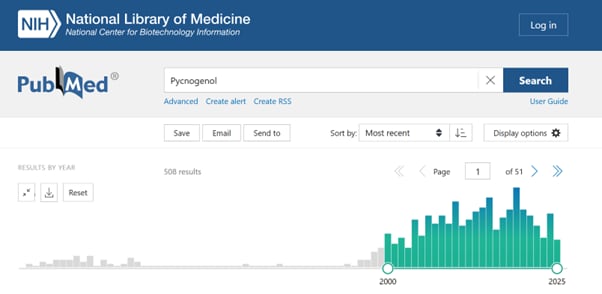The main driver, according to CEO Victor Ferrari, is scientific research, something the company has invested heavily in over the past 40 years. In this regard, Horphag Research serves as a case study for how investing in clinical trials can drive sales and boost brand credibility.
To find out more about the company’s science-driven business model, as well as how Pycnogenol is produced and manufactured, NutraIngredients toured Horphag’s production facility in the Gascony region of Southwest France, gaining exclusive insights into how the company first began and future directions of travel.
The history of Horphag
In the 1920s, Horphag Research was created under the trade name HormoPharma Ltd, with Haimoff initially launching a dietary supplement known as Okasa. Marketed as a 20th century ‘tonic-restorative’, the silver and gold-coated tablets contained vitamins and minerals, such as calcium, iron and phosphorus.
Sales took off following the second world war, coinciding with the large-scale commercialization of vitamin and mineral supplements in the 1950s. However, it was not until the 1970s when Haimoff first began to explore the benefits of French maritime pine bark.
Inspired by French explorer Jacques Cartier, whose crew was cured of scurvy after consuming a tea made of pine needles and bark, Haimoff saw an opportunity to use a by-product of the Gascony timber industry.
Through his research, he discovered that French maritime pine bark contained a unique combination of procyanidins, bioflavonoids and phenolic acids, all of which had potential health-promoting properties.
Around a decade later in 1987, Pycnogenol was bought to the European market as a dietary supplement, with sales expanding into the U.S. in 1991.
“Around this time, marketers were given the possibility to sell an ingredient as a dietary supplement,” Ferrari told NutraIngredients. “They were humble beginnings, and then we started to get traction in America especially around 1994 with the implementation of DSHEA.”
As consumer demand for Pycnogenol rose, Haimoff began to explore how to scale-up production. Thankfully, pine bark was not in short supply, owing to the active timber industry in Southwest France.
Using the bark leftover from lumber production, the company began to transport large quantities to the nearby BioLandes factory for extraction. It also implemented rigorous testing procedures, testing every batch for the right ratios of bioactive compounds as well as any contaminants.
Interestingly, not a single batch has failed over the last 30 years, according to Phillipe Coutiere, CEO of BioLandes SAS. This is partly due to a fully automatized production process, and the fact that pine bark is not subject to seasonal variations, making it stable throughout the year.
Sustainability was, and still is, a key concern for the company, and Horphag continues to upcycle unused pine bark to create both compost and energy for the production plant.
Pycnogenol: supplement or pharmaceutical?
Pycnogenol is also sold as an over-the-counter (OTC) medicine, with the first pharmaceutical preparation launched in Switzerland in 1991. Initially authorized by Swissmedic for the indication of venous insufficiency, Pycnogenol is still registered as an OTC in Switzerland, Brazil, Colombia, Peru, Chile and other South American countries.
Research, research, research
In the early 2000s, Ferrari, as the newly appointed CEO following Haimoff’s passing, saw an opportunity to explore whether Pycnogenol’s health benefits may extend further than previously thought.
With Horphag’s pharmaceutical roots, research had predominantly focused on whether Pycnogenol could support vascular function. This is due to the compound’s ability to promote nitric oxide production and help relax blood vessels, improving elasticity and blood flow.
Following the adoption of the Food Supplements Directive by the European Parliament in 2002 and North America’s implementation of the Dietary Supplement Health and Education Act (DSHEA) in 1994, the company’s research scope extended to include a much larger array of health conditions.

Now, Pycnogenol is featured in more than 60 clinical trials, with over 450 studies and scientific review articles published on PubMed. These persistent research efforts led to the discovery of a wide array of potential benefits, from immune, nervous and reproductive health to digestive, muscular and skeletal health.
“Pycnogenol has four important properties,” said Sebastien Bornet, vice president of global sales and marketing at Horphag. “First of all, it’s a very efficient, very powerful antioxidant. Then it’s a natural anti-inflammatory […], and it helps with blood circulation. Pycnogenol [also] binds to collagen and elastin and has been shown in research to improve and to increase the ability of the body to produce more hyaluronic acid.
“These four properties, if you think about it, all interact with the main body functions— whether it’s respiratory health, cardiovascular function or muscular function, and this is precisely why it helps with so many health benefits.”
These properties have been discovered due to Horphag’s significant investments in scientific research, with Ferrari noting that the company’s sales have grown in line with the number of scientific publications.
“If you compare the published research to the growth, it’s pretty much linear,” he said. “The more research, the more opportunities, the more sales […] We have a steady increase of around 5% to 10% on a yearly basis, and this has been going on since the years we started selling this product.”

Challenges and hurdles
But it hasn’t all been smooth sailing. Ferrari said the company has encountered its fair share of challenges along the way, including regulatory hurdles and the appearance of counterfeit products.
“We are facing an ever-changing regulatory environment,” he said. “We can comply with it because we are always prepared to adapt, but when you change the prerequisites to comply with certain laws and they catch you by surprise, it’s difficult to foresee.”
This is particularly challenging in a global market, Ferrari added, where different regions have different regulatory classifications, labeling and health claim laws, and quality and safety standards.
For example, in Korea, the Ministry of Food and Drug Safety (MFDS) has granted Pycnogenol three associated health claims related to antioxidant activity, the removal of free radicals and menopausal support. However, in Europe and the United States, no health claims have been approved.
“When it comes to European health claim regulations, we think that they started on the wrong end,” Ferrari said. “We believe that health claims should start first with the quality of the product or the ingredient, then with the safety and then ultimately with the reviewed research. Essentially, the process needs to be reversed.”
“I totally understand that claims need to be limited so they are not made in a disease context, but there are plenty of fields where dietary supplements play an active role in healthy aging and healthy lifestyle,” he added.
On top of navigating the regulatory and compliance challenges, Ferrari said the company invests a significant amount of time and money sending out cease and desist letters, and sometimes even taking companies to court over trademark infringement.
“There are many companies who think they can use our research, our brand and our technology for free,” he said. “This puts a strain on the company and is something the industry needs to address. For companies who invest in scientific research, it should not be taken for granted that you can use their data and intellectual property for free.”
Looking ahead
Despite the challenges, Horphag Research does not show any signs of slowing down, with a pipeline of new research and product development in the works.
Ferrari says the company will now look to possible acquisitions and expanding its product portfolio further, with new ingredients soon to join Pycnogenol, Robuvit (a French oak wood extract) and Centellicum (a gotu kola extract).
“The company is now 100 years old, and we’ll hopefully add another 100 years,” Ferrari said. “I won’t be there obviously, but the mentality will remain the same. The philosophy being: curious to develop new things, to incorporate new products, be innovative with our R&D team and develop and check new ingredients.”

